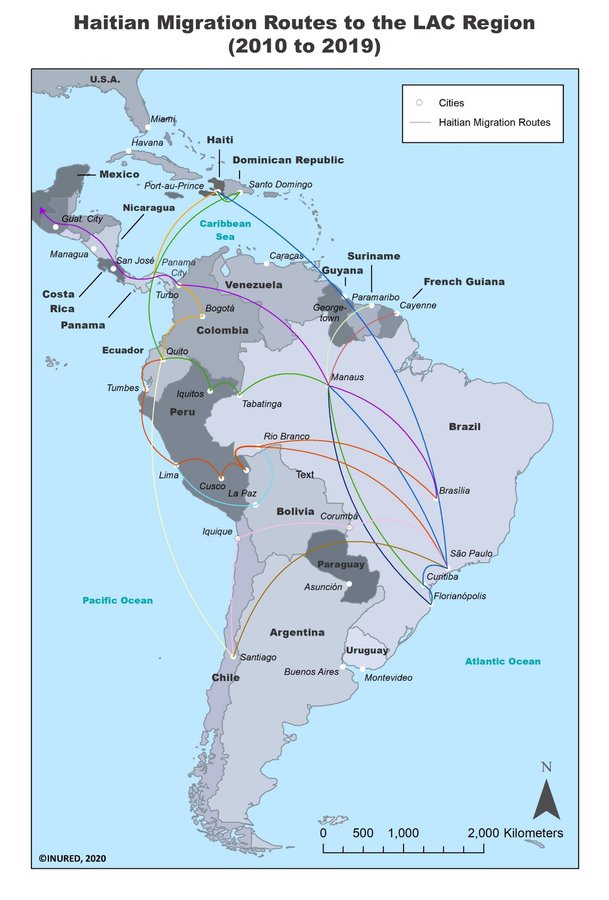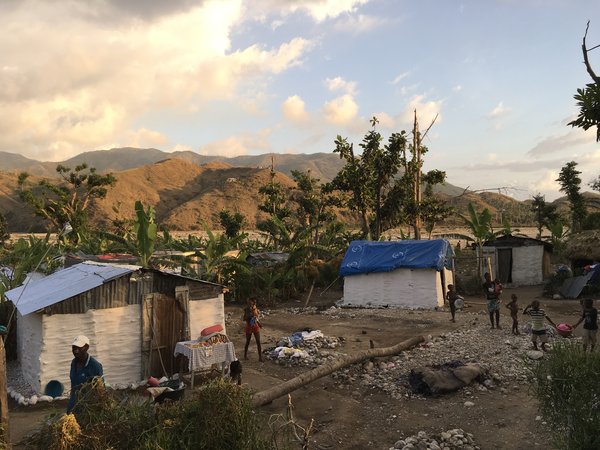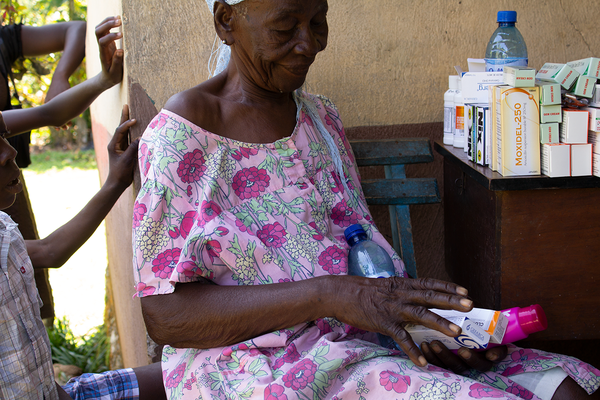
Tarp covered homes on the southern coast of Haiti damaged by Hurricane Matthew in 2016. Photo by INURED 2016. All rights reserved, used with permission.
Between 2010 and 2020, the Latin America and Caribbean (LAC) region experienced an unprecedented increase in Haitian migrant arrivals partly due to favourable migration policies adopted by countries such as Ecuador and Brazil following the 2010 earthquake in Haiti. These policies continue to shape the nature of Haitian mobility in the region today. The complex interaction between political, economic, social and environmental instability at home and economic opportunities as well as migration policies abroad have resulted in the proliferation of Haitian migration to – and mobility within – the LAC region.
Since the 1960s, outmigration and mobility have become constitutive of the Haitian sociocultural landscape as evidenced by the vitality of its dispersed diaspora, the density of its migrants’ transnational networks, and the fact that remittances amounted to almost 40% of the country’s Gross Domestic Product in 2019. Contemporary Haitian migration within the LAC region, however, cannot be reduced to classic push-pull factors: it is characterized by intense circulation and onward migration driven, in large part, by the disintegration of Haiti’s socio-political and economic institutions, chronic structural violence, and the country’s increased vulnerability to protracted natural disasters.
The migration data gap in the LAC region
The interplay between the volatility of life in Haiti, a largely fragmented and incoherent migration policy, and the rise and fall of economic opportunities in different Latin American states has resulted in intense and irregular circulation of Haitians in the region. Brazil now hosts the fourth largest Haitian migrant population in the world (following the US, Dominican Republic and Canada). Following Brazil’s 2015 economic recession, many Haitians migrated to neighbouring countries with more favourable economic conditions such as Chile. Others ventured further north towards the US-Mexico border with hopes of reaching Miami and other Haitian enclaves within the US. Yet, existing data reveal that much remains to be learned about this vulnerable population’s migratory movements in the Global South.
Methodologies used to identify, report on and respond to migrant needs across the LAC region have presented challenges in terms of knowledge generation on Haitian migrants. Data sources often lack comparability, are filled with gaps and/or sparse while the circulatory nature of Haitian migration patterns remain difficult to capture. Further, newly adopted border control policies and securitization efforts, framed as responses to smuggling, human trafficking and terrorism, often increase irregular migration and the illegal networks that support it. Such networks are harder to detect and place migrants at greater risk.
The COVID-19 global pandemic has further widened the data gap. Since March 2020, 197 countries have imposed travel restrictions or closed their borders shifting their focus to domestic issues. Hypotheses derived from exploratory studies on the long-term impact of the pandemic on international mobility suggest what Alan Gamlen calls “the end of an age of migration”. However, some evidence suggests that while legal migration may have been stifled such unprecedented restrictions have, perhaps unwittingly, facilitated irregular migration.
The circulatory nature of Haitian mobility within the region makes it difficult to identify and quantify migrant flows and populations within each country in the LAC region, particularly in Brazil. This dynamic often results in an over-reliance on anecdotal information, at times provided by government officials, in lieu of hard data. For example, the Haitian government often cites untested statistics, yet fail to make sources publicly available. These data gaps as well as the Haitian government’s lack of transparency and accountability towards its citizens exacerbate Haitian migrant vulnerability in the region.
Migration data and policy: a fragmented region
Since 2010, migration policies adopted within the region have been fragmented and constantly changing. Between 2012 and 2015, Brazil would change its migration policy on Haitian migrants four times, applying and then removing annual quotas on visa emissions and expanding the number of embassies from which migrants could apply. Despite these changes, long wait times created a demand for the services of informal and underground intermediaries, further facilitating irregular migration. In 2012, Peru would require in-transit migrants to secure temporary tourist visas. Although these policies were intended to curb irregular migration, the phenomena persisted as 46% of Haitians arrived by land – mostly through Peru – until 2017.
Understanding Haitian migration has also proven challenging due to data collection methods; some country datasets do not include nationality (e.g., Peru, Venezuela, Guyana) and for those that do, data is often generated based on different data capturing methods. Between 2012 and 2019, data on arrivals and departures in Ecuador resulted in a balance of just under 40,000 Haitian migrants rendering it impossible to determine how many Haitians remained in-country versus those who migrated to neighbouring states. In Brazil, a variety of data sources from government entities using different methodologies provide a fragmented picture of Haitian migration. Disparate and, at times, non-existent data sources in the LAC region greatly limit regional analyses on Haitian migration, as information between countries cannot be objectively compared. Addressing these gaps is essential to identifying the specific needs of this heterogenous, highly mobile and increasingly vulnerable population.
Conclusion and recommendations
Although many organizations are looking to big data as a solution to data gaps, these data systems frequently fail to capture marginalized populations, as they often do not participate in the formal economy and are less fluent in the technologies needed to create data. Therefore, government data sources will remain an important provenance for migration information and knowledge creation. Governments in the LAC region should harmonize data collection methodologies in order to achieve better governance cooperation. Research programs and institutions in the region should also coordinate their actions, develop creative methodological approaches to capture data, disseminate analyses via open-access platforms that can serve public and private institutions in these countries and beyond.
As COVID-19 has intensified an ethos of border securitization in the name of national security, irregular migration will continue to rise and comprehensive data on migrant populations will become more difficult to obtain. If this remains unaddressed, it will further limit our ability as stakeholders to understand the nuances of migration and mobility in the world and adopt policies that can effectively remedy them.



